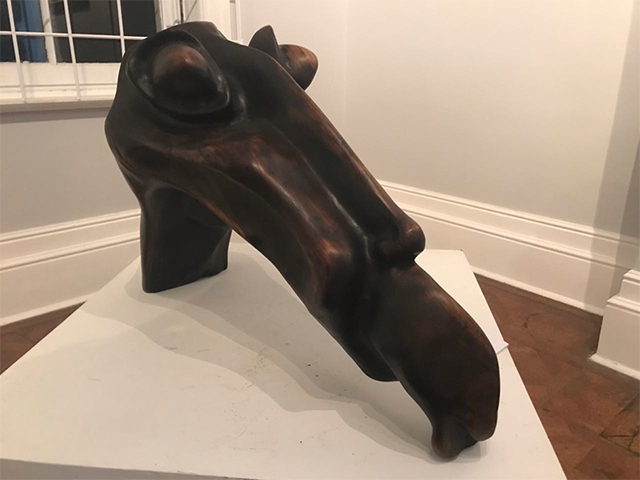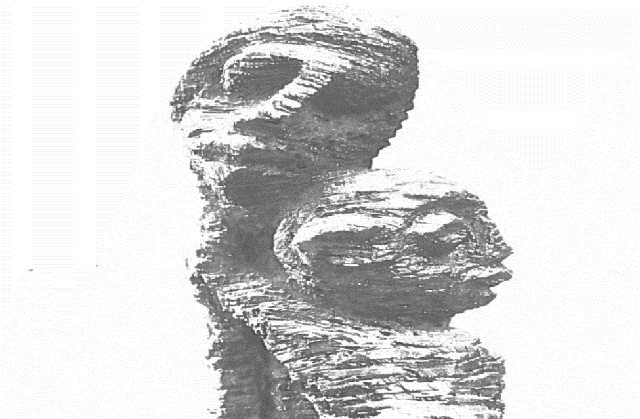Writing: Reviews & Think Pieces
Review of Lucas Sithole’s Manzitoti (1985) and Mother and Child (1963), as part of the De Beers Centenary collection at the Ann Bryant Main Gallery
On the 24th of May 2018, eleven Arts of Africa and the Global Souths members travelled to the much-anticipated opening of the De Beers Centenary exhibition at the Ann Bryant Main Gallery in East London. This exhibition showcased works from artists such as, Dumile Feni and Gerard Sekoto, featuring the prolific Lucas Sithole’s Manzitoti (1985), (Fig. 1), crafted from Zulu indigenous wood. Standing firmly on a crisp white plinth, it immediately captured viewers’ attention to the intricate detail of his wood carving ability. Sithole’s method alludes to both human and animalistic hybrid qualities, expanding further from his earlier works, such as, “Mother and Child” (1963), (Haenggi 1979: 35), (Fig. 2). Both simplistic and emphatically made, this work renders not only a different technique, but portrays ‘mother and child’ in a manner only true to Sithole’s craftmanship.
The aforementioned statement adds to how E.J de Jager[1] affirms his figurative sculptures to be “especially African in concept, and they are characterised by simplicity of form and a high degree of sensitivity”, alluding to how the aesthetic appearance of Manzitoti (Fig. 1), ranges in depth from all angles carved and shaped demonstrating Sithole’s ability to move between realistic human and animalistic depictions, which in return contributes to Sithole’s attributes of working in a range of in medium, sculpturing in hardwoods, stone, liquid steel and bronze. This handcrafted sculpture filled the entire space, inconspicuously surrounded by the vivid strokes of George Pemba’s oil paintings making Sithole’s work more plausible to how he ranged in mediums, including “painting under Cecil Skotnes at the Polly Street Art Centre, Johannesburg, for one year (1959/60), thereafter establishing his medium, sculpture in hardwoods, stone, liquid steel and bronze” (Haenggi 1979: 8). The work Manzitoti was polished in such a way that it appeared almost bronze-like. Standing in awe in front of this meticulously made sculpture, I am attracted to look closer at the defined jaw structure, the nose or spout that seemingly flows into a closed cupped mouth.
This exhibition was concurrently opened with the Umtiza Arts Festival, which ran from the 23rd to the 27th of May 2018. The De Beers Centenary Collection was only on-display for three days, while the entire collection was not on display and only a selected few artists were represented at the Ann Bryant Gallery. The reason I draw your attention to the almost ‘fight or flight’ attributes of this collection is that the initial exhibition[2], curated by E J De Jager in 1992, was the first occasion on which the aforementioned collection could be viewed.
I was introduced to the De Beers Centenary Art Collection ten years ago. At the time, I was a scholar in a formal model-C school, not knowing then of how privileged I truly was to have access to the collection. A catalogue titled ‘Selected Black Artists 1941 – 1992 Homage to Black Artists’ by the present senior manager and curator of the De Beers Centenary Collection, Vuyani Booi (2003: 5), was given to each student at the time, which was not only outdated, but depicted a select few rather than all the works from the collection. This catalogue offered brief glimpses into the collection, which today, consists of approximately 5000 items by more than 180 black South African artists (Jikelo1993: 34). However, De Jager (1992: n.p) claims that the collection consists of “more than 170 contemporary Black artists”. Thus, both authors indicate a different number of Black South African artists in the collection and the use of the word ‘contemporary’ is only used by Jikelo. This could be potentially confusing when locating the collection within a broader South African context, which draws on a comparison made by Simon Njami, who refers to Africa being undoubtedly defined within “a cultural syncretism underlying all contemporaneity” (Njami 2005: 15).
Could the initial exhibition and collection not be seen as an ‘idea of modernity’ or a hybrid of Eurocentric ideology? Alternatively, both the exhibition and collection have come to exist within a space of contemporaneity, which has found itself within a European ideology, yet existing as “Africa [that] refuses to hide itself” (Njami 2005: 15).While these apparent influenced ideologies are present within both the exhibition space and the collection, it is through “the contact and emergent acculturation between the indigenous South African Black cultures and the economically and politically dominant European culture bought many changes to Black society in all spheres of existence” (De Jager 1992: n.p). Both the collection and exhibition have come to exist as an interwoven collaboration between interactions of reciprocal understanding, “and all cultures involved are to some degree subjected to a measure of change and influence by the other” (De Jager 1992: n.p).
During the opening speech, Professor Sakhela Buhlungu, the Vice Chancellor of the University of Fort Hare, stated that an amount would be charged from next year (2019) to access the gallery. This contradicts S M E Bengu’s (1992: n.p), statement in his ‘foreword’ for the initial exhibition Images of Man, which sought to “contribute to the process of communicating understanding by sharing its large and comprehensive art collection with as wide an audience as possible”. I will end with this thought: When will the De Beers Centenary Collection be truly made available to the public or will it remain tightly concealed like a well-kept secret?

Lucas Sithole, Manzitoti (1985), Zulu indigenous wood, photography Brünn Kramer.
 ?
?
Lucas Sithole, “Mother and child” (1963), Rhodesian teak, photography J. Hutton, Durban. (Reproduction taken from F.F. Haenggi. 1979. Lucas Sithole 1958 - 1979 A pictorial review of Africa’s major Black sculptor. Gallery 21 and The Haenggi Foundation Museum: Johannesburg.)
Bibliography
Bengu, S.M.E 1992. ‘Foreword’ in E.J De Jager Images of Man. Alice: Fort Hare University Press, pp. n.p.
Booi, V.G. 2003. Selected Black Artists 1941 – 1992 Homage to Black Artists. Alice: University of Fort Hare.
De Jager, E.J. 1992. Images of Man Contemporary South African Black Art and Artist: a pictorial and historical guide to the collection of the University of Fort Hare housed in the De Beers Centenary Art Gallery. Alice: Fort Hare University Press.
Haenggi, F.F. 1979. Lucas Sithole 1958 - 1979 A pictorial review of Africa’s major Black sculptor. Gallery 21 and The Haenggi Foundations Museums: Johannesburg.
De Jager, E. J. 1979. ‘Comments’ in F.F. Haenggi Lucas Sithole 1958 - 1979 A pictorial review of Africa’s major Black sculptor. Gallery 21 and The Haenggi Foundations Museums: Johannesburg, p.13.
Jikelo, C. 1993. ‘The De Beers Centenary Art Gallery: At the University of Fort Hare’. Optima, 39 (1): 34-40.
Njami, S. 2007. ‘Chaos and Metamorphosis’. Africa Remix: contemporary art of a continent. pp. 3-23.
[1] See Contemporary African Art in South Africa, page 28.
[2] Title of text: Images of Man: Contemporary South African Black Art and Artists: a pictorial and historical guide to the collection of the University of Fort Hare housed in the De Beers Centenary Art Gallery
Natasha Bezuidenhout is an MFA student with the NRF/DST SARChI Chair Geopolitics and the Arts of Africa, Arts of Africa and Global Souths research programme headed by Prof Ruth Simbao at the Department of Fine Arts, Rhodes University, South Africa
Last Modified: Mon, 11 Feb 2019 10:49:46 SAST
